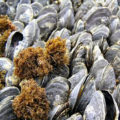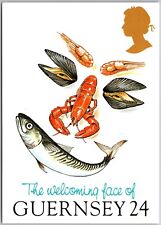
Shellfish living in the world’s temperate coastal ecosystems are under threat from increasing ocean acidification, says Smithsonian scientist Whitman Miller. The acidification is being caused by rising levels of atmospheric carbon dioxide, Miller reported in the journal PLoS ONE.
For shellfish and other organisms that have calcium carbonate shells, the problem begins when atmospheric CO2 dissolves in seawater and creates carbonic acid that is then rapidly transformed into carbonate and bicarbonate ions. Increased acidity tips the balance toward bicarbonate formation and away from carbonate. Less carbonate in the water means that shellfish have fewer building blocks to generate their shells. If the water is acidic enough, their shells can even begin to dissolve.
“Estuarine and coastal ecosystems may be especially vulnerable to changes in water chemistry caused by elevated CO2 because their relative shallowness, reduced salinity and lower alkalinity makes them inherently less buffered to changes in pH than in the open ocean,” said Miller. For many calcifying organisms, CO2-induced acidification poses a serious challenge because these organisms may experience reduced rates of growth and calcification that; “when combined with other environmental stresses, could spell disaster.”
To test the effects of acidification, Miller monitored their growth and measured the amounts of calcium carbonate deposited in larval shells over the course of one month. Miller and his team found that Eastern oysters experienced a 16 percent decrease in shell area and a 42 percent reduction in calcium content when specimens in the pre-industrial CO2 treatment were compared with those exposed to the levels predicted for the year 2100. Surprisingly, the closely related Suminoe oysters from Asia showed no change to either growth or calcification.
The results suggest that the impacts of acidification may be tied to a species’ unique evolutionary history and environmental setting, implying that predictions may be more complex than previously thought. “In the Chesapeake Bay, oysters are barely holding on, where disease and overfishing have nearly wiped them out. Whether acidification will push Eastern oysters, and the many species that depend on them, beyond a critical tipping point remains to be seen,” said Miller.
With numbers so critically low – the oyster population in the Chesapeake Bay today stands at just 2 percent of what it was in colonial times – future losses could have dire consequences, both environmentally and economically. Indeed, the recently enacted Federal Ocean Acidification Research and Monitoring Act of 2009 recognizes the urgent need to begin addressing impacts of acidification on estuaries and their biota.
With the continued burning of fossil fuels, further acidification is unavoidable. Miller is keenly interested in what the biological and ecological responses will be in order to better inform current and future environmental restoration efforts. “In a high CO2 world, calcifying organisms may well begin to lose out to competition with non-calcifiers, a situation that could fundamentally change benthic communities. Understanding how such changes may play out in estuaries and coastal waters, which teem with calcifying biota, and which are also the centers of many commercial fisheries and human activities, seems especially urgent,” Miller concluded.
Related:
Ocean acidification speeding up
Climate “Tipping Points” Identified
Carbon Dioxide 1, Coral Reefs 0
Plummeting Shellfish Stocks Blamed On Shark Overfishing
Prozac In Wastewater Threatens Mussels


















Comments are closed.